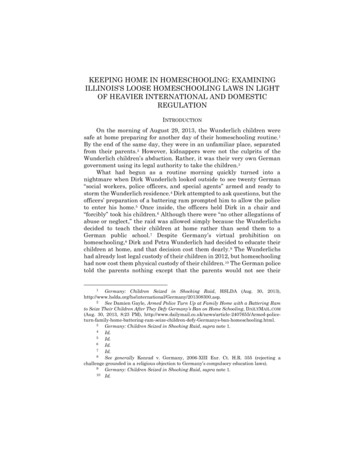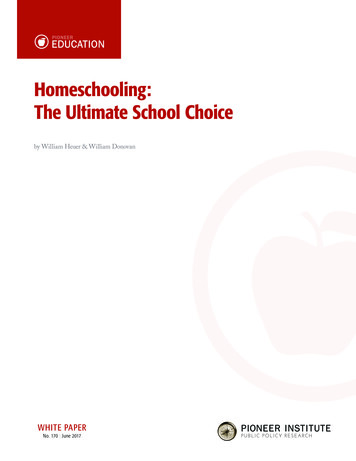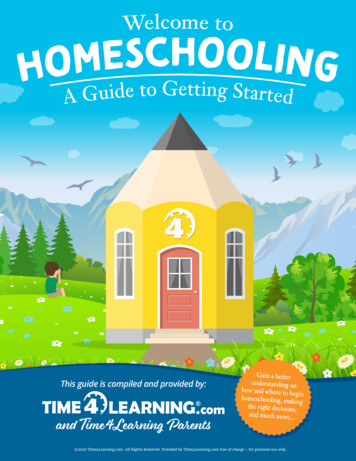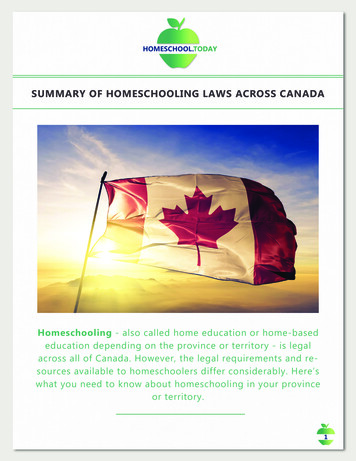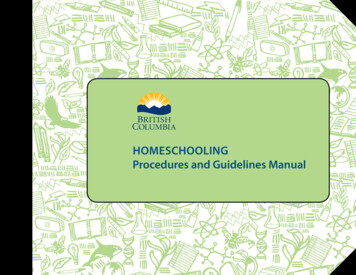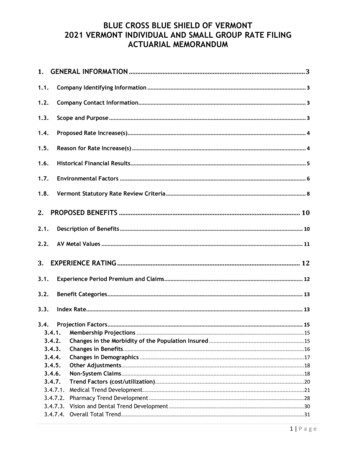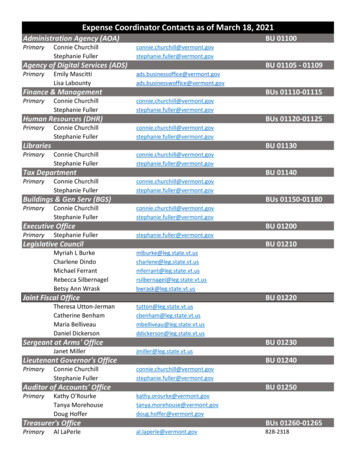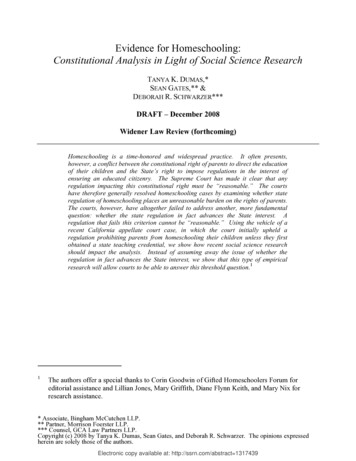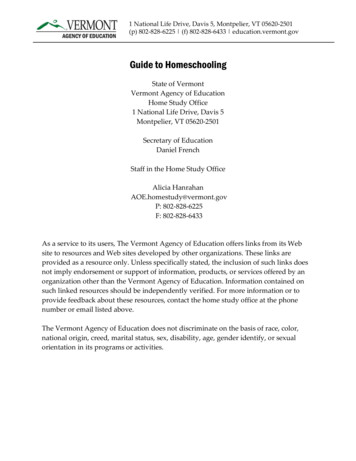
Transcription
1 National Life Drive, Davis 5, Montpelier, VT 05620-2501(p) 802-828-6225 (f) 802-828-6433 education.vermont.govGuide to HomeschoolingState of VermontVermont Agency of EducationHome Study Office1 National Life Drive, Davis 5Montpelier, VT 05620-2501Secretary of EducationDaniel FrenchStaff in the Home Study OfficeAlicia HanrahanAOE.homestudy@vermont.govP: 802-828-6225F: 802-828-6433As a service to its users, The Vermont Agency of Education offers links from its Website to resources and Web sites developed by other organizations. These links areprovided as a resource only. Unless specifically stated, the inclusion of such links doesnot imply endorsement or support of information, products, or services offered by anorganization other than the Vermont Agency of Education. Information contained onsuch linked resources should be independently verified. For more information or toprovide feedback about these resources, contact the home study office at the phonenumber or email listed above.The Vermont Agency of Education does not discriminate on the basis of race, color,national origin, creed, marital status, sex, disability, age, gender identify, or sexualorientation in its programs or activities.
Table of ContentsWelcome . 3Who Homeschools and why? . 3Determining Learning Style . 4Additional learning sub categories. 5Tips for Teaching Auditory Learners . 6Tips for Teaching Visual Learners . 6Tips for Teaching Kinesthetic Learners . 7Homeschooling Curriculums . 7Subject and Core Curriculums/Distance Learning Programs. 9Providing Content to your plan . 11List Approach with required area, and topics/skills . 11Narrative Approach - with required area, and topics/skills . 13Unit Studies Approach - required area, and topics/skills . 14Theme Approach - required area, and topics/skills . 15Mathematics: . 15Citizenship, History, and Government:. 16Physical Education: . 16Comprehensive Health: . 16English, American and Other Literature: . 16The Natural Sciences: . 16When Problems Arrise . 22How to Find Resources . 24Conclusion . 25Guide to Homeschooling(Revised: February 28, 2019)Page 2 of 25
WelcomeWelcome to Home Study! The Agency of Education’s Home Study Office is pleased toprovide families with this updated document on homeschooling.Homeschooling can be an exciting adventure for a family. It can also be a ratherdaunting experience as you try to enroll, choose materials, find resources, and set upyour program. This document is intended to help you determine how to uncover yourstudent’s learning style, learn how to evaluate and provide the content your child willbe learning during the school year, how to plan your schedule, how to avoid commonchallenges, and how to find resources. We hope to help families who are currentlyenrolled, who are considering enrolling, or who would just like some information aboutthe process.The more information you are able to gather and explore, the better able you will be, topurchase or design a curriculum that is appropriate for your student and your family.If reading through this material leaves you with more questions, we encourage you tocontact us at the Home Study Office at 802-622-1254, so we can discuss them with you.We are here to help! You may also find support in your local public library or by askinggroups on social media.Public libraries are terrific resources and are generally available to provide informationabout curricula, general questions, and various resources. They are generally aware oforganized activities for students and may be able to offer parent/guardian support.Local and Statewide homeschooling organizations, even those not in your home state,can provide support to you as you begin, carry out, or finish your homeschooling year.For a list of known local and statewide homeschooling groups, contact the Home StudyOffice.Who Homeschools and why?Families choose to homeschool their children for a variety of reasons: individualizedlearning, safety, belief systems, family togetherness, and academic excellence.Regardless of the reason, it is important to review the VT Home Study Regulations, tokeep updated on any changes with homeschooling statutes.Vermont requires all students between the age of 6 and 16 to be enrolled in a homestudy program, independent school or public school by the beginning of each schoolyear. If students are not officially enrolled in one of these three programs, the studentsare considered truant, and the public school shall notify the local truancy officer.Home Study Enrollments must be received or clearly postmarked by midnight onAugust 1 to be considered complete. A MCOS must be submitted for each child whoGuide to Homeschooling(Revised: February 28, 2019)Page 3 of 25
does not have MCOS exemption as well as students who are 12 years old at the time theenrollment (even if the student is eligible for the exemption). The student must not havebeen withdrawn during the school year, for this to be considered a school year. See 16V.S.A. §166b (k). For definitions of a complete year and MCOS exemption, please referto our FAQ or VT Home Study Guidelines listed on our websiteSubmission of an enrollment packet does not mean that the student has been enrolled ina home study program. When students are officially enrolled in a home study program,families will receive a complete letter from the Home Study Office.There are several ways to submit enrollment packets; please only choose one version(i.e. do not submit a paper copy and submit it via email):1. Complete the forms electronically online2. Complete the forms and email them to AOE.HomeStudy@vermont.gov Pleasenote that while the forms will be secure once they arrive at AOE, they are notsecure during the email transfer.3. Print off the forms, fill them out and mail, walk-in or fax them directly to:Home Study/VT Agency of Education1 National Life Drive, Davis 5, Montpelier, VT 05620-2501Fax: 802-828-6433Additional questions may be referred to the Home Study Team at 802-828-6225 or emailAOE.HomeStudy@vermont.gov.Determining Learning StyleOne big step toward homeschooling successfully, is determining your student’slearning style. Many people recognize that every person has different learning style andtechnique. A student’s learning style, or learning modality, describes how they receiveand process information. Figuring out your student’s approach could allow you tooptimize teaching AND learning at the same time. The three main types are:Auditory processors, who learn by listening or talking. These students do well withlectures and read-aloud, and respond well to oral directions.Visual processors, who learn by seeing or making images in their mind to rememberinformation. These students also remember by taking notes, making lists, andhighlighting key concepts. They typically like to draw, scribble, and usepictured details and colors to help recall information.Physical or Kinesthetic or tactile processors, who learn by doing hands on work, orlearning through exploring with their senses. They typically do well with puzzles, ormanipulatives, and enjoy being active while learning.Guide to Homeschooling(Revised: February 28, 2019)Page 4 of 25
Additional learning sub categoriesMusical learners who prefer using sound and music, often humming or tapping whilelearning.Verbal processors who use words, both in speech and writing.Social learners who prefer groups or working with other people.Logical processors, who prefer systematic, sequenced steps in learning. They learnthrough patterns, and utilizing a step-by-step process.Solitary learners who enjoy researching on their own, and working alone. Typically,these students are private, introspective and independent. They find it easy to focus ona task, and enjoy journal writing.Finally, Combination processors who learn using two or more of these styles, just tokeep us on our toes!A student’s primary learning style is referred to as his or her "dominant modality". Thenext favored learning style is referred to as the "secondary modality". As adults we haveour own preferences as to how we receive or communicate information, and wetypically teach our children in a way that makes sense to us. That can be counterproductive. For example, if you tell a kinesthetic student to sit still and listen, or to tell amusical learner not to hum while writing, we take away the very tools the studentneeds to learn. Teaching to your student’s learning style makes learning more efficientand enjoyable for everyone. It also limits conflict and your student learn to maximizetheir strengths.The best way to determine your student’s learning style is to watch their movements.Consider the following: Does your student express himself or herself through movement, talking, orbody language?Do your student’s primary interests involve pictures, sounds or movement?When encountering something new, does your student want to examine it, askquestions about it or touch it?In a group setting, does your student watch others, talk to others, touch others orencourage others to move?How does your student communicate? What forms of communication does yourstudent best understand?How does your student solve problems? What brings about success or causesfrustration?Guide to Homeschooling(Revised: February 28, 2019)Page 5 of 25
It may take some time and experimentation to figure out your student’s dominantlearning style. The goal is to find ways to work with, not against, his or her naturalstrengths.When teaching children with different learning styles, it is not always necessary to useexpensive programs. Try using the suggestions below to tailor your curriculum to meetyour child's needs.Tips for Teaching Auditory Learners Read information and directions aloud.Give your student the opportunity to discuss the directions before beginning anassignment.Use oral drill for practice.Provide opportunities for group study.Make a song or poem out of information that needs to be memorized.Have your student record information and play it back in order to commit it tomemory.Motivate reluctant readers through the use of rhyming books, poetry, andaudiobooks.Tips for Teaching Visual Learners1.2.3.4.5.6.7.8.9.Teach your student to take notes so he has something to look at while listening.Put information in the form of diagrams, charts, maps, graphs and drawings.Use a highlighter for key points.Teach your student to put information in the form of an outline.Give written, as opposed to verbal, instruction.Draw pictures to help explain new concepts and then explain the pictures.Color code things.Use flashcards and worksheets, as opposed to oral practice.Motivate reluctant readers with books that have interesting pictures. Whenbooks have been made into a movie, view the movie before reading the book togive your student a visual to refer to.Guide to Homeschooling(Revised: February 28, 2019)Page 6 of 25
Tips for Teaching Kinesthetic Learners Associate memorization of facts with bodily movement such as taking steps,jumping on a trampoline, swinging, etc.Take frequent breaks. Alternate short periods of seatwork with periods ofactivity.Let your student complete assignments while rocking or sitting on a bouncy ball.Let your student stack blocks, squeeze a ball, build clay models, or draw whilelistening.Record information to be memorized and let your student listen while swinging,jogging or engaging in physical activity.Use manipulatives to teach mathematical concepts.Use textured letters and alphabet magnets to teach spelling and reading.Have your student write in sand, shaving cream or pudding to practice spellingor letter formation. You can also write on your student’s back with your finger orhave your student use his finger to write in the air.Let your student write on a large chalkboard or dry erase board when studying.Have him or her erase information as it is learned.Let your student run his finger along the words, trace or highlight informationwhile reading.Motivate reluctant readers with pop up, scratch and sniff, lift the flap, push/pulltabs and other books that invite activity. Older readers may prefer, books thatfeature adventure or sports.Homeschooling CurriculumsThe number one question most homeschoolers ask is, “What curriculum do you use?”The curriculum is the lessons and content that is taught within a specific subject. Itincludes the goal and objectives of the lesson, or the desired outcome within that subjectarea. For example: Big History Project Curriculum teaches, Beginning of the Universeto Early Man. Each unit has daily lessons, and each have a learning goal, but the overallgoal of the curriculum is to teach students about the beginning of the universe to earlyman.Guide to Homeschooling(Revised: February 28, 2019)Page 7 of 25
Questions to ask yourself before seeking out homeschool programs and curriculums:1. What are the needs and goals of the student and/or the family? How many students will be using the curriculum? Do we need a flexible schedule? What is a typical day going to be? What do I want the student/s to learn?2. What type of curriculum do I want to use? What subjects will you teach your child? Do you want a program that is secular or faith based? Are you willing to use different curriculum providers for different subjects or doyou want to purchase from one supplier? Will you keep records and grades? Do you want a program with pre-planned lessons and a set schedule? Do you want a program that promotes independent study or one that relies onparent interaction? How much time do you have available to spend on formal lessons? Do you need to combine children of different ages into one program? Will your program need to address learning difficulties or cater to a specificlearning style? Does your preferred program include worksheets, tests, hands-on projects oractivities?You can create your own curriculum, purchase a complete program from a company,have your student work online, do a partial enrollment at your public school, or yourlocal college.More considerations:1. I like this curriculum because2. I don’t like this curriculum because3. It’s weakness is4. It’s strengths are5. Are there extra materials needed (equipment, paper, charts, etc.)?6. Are there enough supplemental materials/activities to stimulate a child who hasproblems in, or who is gifted in this area?7. What is the cost of the curriculum? What is the cost of extra materials, if needed?8. Is the curriculum demanding or flexible?9. Are the materials consumable (workbooks or hardcover)?10. Is a teacher’s book/guide available? If so, is the same as the student edition, butwith answers?Guide to Homeschooling(Revised: February 28, 2019)Page 8 of 25
11. Are the pictures and illustrations colorful or black-and-white? Are the graphs,illustrations, and examples helpful or confusing?Before making your final selection, read product reviews about thecurriculums/programs you are considering. You may also want to attend a home schoolcurriculum fair so you can: view the products in person and talk to otherhomeschoolers. You can also look for used homeschool books and affordablehomeschooling curriculums at discount book stores, thrift stores, and garage sales.Search the internet for free homeschooling materials, games and worksheets. There areso many options for curricula material. Finally, check with your local library to see whatresources they may offer.Vermont home study statute requires that a detailed outline, also known as a MinimumCourse of Study (MCOS), to be submitted each year (unless the student qualifies for anexemption-see guidelines). This includes the various topics and skills that a studentwould be learning in the course of the year, based on age and ability. The state doesfactor in disability (if applicable).You can organize your curriculum any way you would like, as long as we can findtopics/skills for each of the required areas.When providing the Home Study Office the MCOS make sure you complete the formand mail, email, fax, or upload it into our electronic system. Here are some ways inwhich you can fill out the MCOS. Provide a copy of the Scope and Sequence from your book or online program. Photocopy information about courses from other publications such as catalogs. Photocopy the table of contents from textbooks your child is using. Handwrite or type the content to be learned in each area on a piece of paper.While the AOE does not endorse any one specific curriculum, below are curriculumsthe Home Study Office is familiar with:Subject and Core Curriculums/Distance Learning ProgramsA-Beka - faith basedAcellusAlpha and Omega - faith basedAny Child Can WriteAround the World in 180 DaysBig History Project- Free website through Gates FoundationBob Jones - faith basedCalvert School - online secularCharlotte MasonClassical Conversations - faith basedGuide to Homeschooling(Revised: February 28, 2019)Page 9 of 25
Discoveryk12 - FreeGo NoodleHandwriting Without TearsHorizons- faith basedJames MadisonK12 onlineKahn Academy - FreeKeystoneLearning A-ZRazz-Kids-ReadingReading A-ZELL Edition A-ZScience A-ZVocabulary A-ZWriting A-ZLaurel SpringsLiberty University - faith basedLIFE school LDS - faith basedLinda Mood Bell & Linda Mood Bell Academy- English/Lang. Arts/Reading/MathMinecraft EducationOak MeadowOrton GillinghamPenn FosterProdigy - MathReading EggsSaxon MathSeton - faith basedSingapore MathSonlight - faith basedStarfall - Reading and SpellingSwitched on Schoolhouse - faith basedTime 4 LearningUniversal Class - through VT public libraries - FreeGuide to Homeschooling(Revised: February 28, 2019)Page 10 of 25
Providing Content to your plan(Includes the MCOS required areas for 12 and under)The following examples of curricula are to assist you in creating your own curriculumfor you child. The curriculum must be age appropriate for each child enrolling intohomeschool.List Approach with required area, and topics/skillsPlease avoid using too many emphasis fonts, such as bold and italics. Highlighting too muchtext decreases the effectiveness of emphasizing specific instructions or information.This approach is also considered to be the traditional method, or the school model approach.Families might start with this style because it is the most familiar, and it is structured to coverall areas. Each subject is based on a scope and sequence method, which answers what is goingto be taught and when, allowing for specific lesson plans. Typically, online curriculums,workbooks, and textbooks follow this type of approach. For example:Basic Communication Skills: Reading/Writing – topics/skills to include the following: (You mustinclude types of writing the student will do) orally expressing him/herself clearly, concisely, and fluently develop language through vocabulary development, reading readiness andreading activities recognition of likenesses and differences thought and idea development phonics manuscript writing skillsBasic Communication Skills: Math – topics/skills to include the following: basic addition and subtraction (review) understanding Place Value involving two digit numbers ability to write and solve problems in which he/she must first decide if he/she isto add or subtract, then the ability to carry out the appropriate operation concrete experiences necessary to begin the process of understandingmultiplication and divisionCitizenship, History, And Government – topics/skills to include the following: Recognize and accept likenesses and differences in people around the world Develop a deeper appreciation for home, family, and community life Develop an awareness of responsibilities in home, family, and community life Develop an awareness and concern for others, how they can be helped, how theycan help he/she Further awareness of environmental issues Geography of the United States of AmericaGuide to Homeschooling(Revised: February 28, 2019)Page 11 of 25
Will continue to read aloud biographies of important and representative figuresin American history Presidents from Vermont Please note that you cannot list the broader topics of US History on the MCOS.The specifics need to be broken down.Physical Education- physical skills to improve balance, speed, strength, stamina, andcoordination; topics/skills to include the following: Hiking Biking Yoga Skiing and Sledding SwimmingHealth – topics/skills to include the following: Identify body parts and functions Muscle coordination activities (large muscle and small muscle) Understanding Adolescent Growth Practice habits of good health/eating Understand the importance of safety Practice basic safety precautions Dangers of Drugs and AlcoholEnglish, American, And Other Literature- topics/skills to include the following: Will listen to reading of literature including fiction, non-fiction, poetry, historicalbiographies Acting out stories Will keep journal Will dictate creative writing (You could provide a sampling of titles or authors the child will read)Natural Sciences- topics/skills to include the following: Learn to observe carefully Ask questions Search for answers Record findings Become actively involved in experimenting Use of field guides Visit the Montshire Museum (you must provide content to be learned here, orbrochure)Guide to Homeschooling(Revised: February 28, 2019)Page 12 of 25
Provide a list of specifics topics to be taught within an area of Science (i.e. BlackHoles, Dark Matter, planets in the broader topic of Astronomy). Please note thatyou cannot list the broader topics of Earth Science or Chemistry on the MCOS.The specifics need to be broken down.Fine Arts- topics/skills to include the following: Arts and crafts projects Will attend a variety of performing arts events throughout the year (Providenames of events) Visit art museums (provide some content to be learned) Music: listening, signing, and use of rhythm instrumentsNarrative Approach - with required area, and topics/skillsThis approach covers the core subjects of reading, writing, and math with short, interest-filledlessons and incorporates interests with real-life experiences. For example:1. Basic Communication Skills:Reading/Writing: Our topics/skills include independent reading for pleasure and a purpose,vocabulary development, a review and reinforcement of writing purposes, filling out jobapplications, foreign words used in English, geographical dialects, writing parables, satires,allegories, and elegies.Math: Topics/skills include one-half year of algebra II and one-half year of consumer math (thefirst half of these two subjects was done two years ago). Topics/skills will include systems oftwo, three, and non-linear equations, uniform motion, chemical mixture, and travel problems,area, volume, and unit problems, right triangles, trigonometry, polar and rectangular coordinates and vectors. Consumer math topics will include taxes and insurance, transportationand travel, sports, hobbies, and recreation, occupations, computers, and using statistics.2. Citizenship, History, and Government: In Vermont And the United States: Ourtopics/skills include the highlights of U.S. history from 1776 to the presentstudied through novels and biographies, especially of women; basic documentsof the U.S. government; advanced map and globe skills, the state constitutionand the rights and responsibilities of being a resident of Vermont, and the poetryon old Vermont gravestones.3. Physical Education: We will participate in folk dancing, soccer, volleyball,bicycling, jogging and hiking, swimming, skating, and cross-country skiing.4. Comprehensive Health: Our health topics/skills include a continued study ofnutrition, the effects of tobacco, drugs, and alcohol, the detrimental effects andthe prevention of the AIDS epidemic, and disease prevention through a healthfullifestyle. New topics will include the U.S. food choices and supply throughGuide to Homeschooling(Revised: February 28, 2019)Page 13 of 25
history; the uses and bodily needs of the five nutrients, and the effects of overuse of antibiotics by man and animals.5. English, American, and other Literature: Our topics/skills include Americanbiographies and autobiographies, parables, satire, allegories, and elegies,including Vermont gravestone poetry. We will continue to foster an appreciationof great literature and encourage our children to choose reading materials wisely.(You could provide specific titles or authors to be read.)6. The Natural Sciences: Our topics/skills include the sources of electrical powerincluding solar, hydro, and nuclear, electrical terms and household usage,energy; soil composition and types, plant needs and the nutrients in the soil, soiltesting, pH, acids and bases, and hydroponics; uses, needs of the human body,and sources and a review of atoms, elements, and the periodic table.7. The Fine Arts: Our topics/skills include American artists, painting withwatercolors, drawing caricatures, bell ringing, and folk dancing. Our childbelongs to two traveling, performing early American dance groups, (GreenMountain Volunteers and Galopede) a teenage variety dance group (Teen TwoStep), and performs on a regular basis throughout Vermont, New York,Connecticut, Massachusetts, and Canada. Our child also belongs to a church bellringing group.Unit Studies Approach - required area, and topics/skillsThis method allows using an interdisciplinary approach for the year, focusing on onetopic, which will include many different subject areas. Unit studies can be used at anygrade level and can take anywhere from days to weeks to complete. For example:Native Americans:The Education of Little Tree (reading)Indians (literature)Crafts (fine arts)Research of history (social studies)Fiction (reading)Games and dances (physical education)Artwork (fine arts)Field Trips (fine arts)Nature awareness (conservation, ecology) (science)Map work (social studies - geography)Music (arts)Spacious Skies: (science)Weather observation (science)Scientific process (math)Charts, graphs, instruments (math and history)Guide to Homeschooling(Revised: February 28, 2019)Page 14 of 25
Weather myths (science)Sky journal (reading)Creative writing (writing)Seasons – effects on people (health and science)Clouds (science)Different climatic regions (social studies)Sky vocabulary (reading)Solar System (science)Sky music (fine arts)Photography (fine arts)Theme Approach - required area, and topics/skillsLike the unit studies method, the theme approach allows the student to choose a topicand explore it incorporating a variety of subjects into that single topic or theme.The Game of BaseballBasic Communication Skills:Reading and Writing: Silent and oral reading to include: fiction, biographies,autobiographies, newspapers and research/informational/non-fiction publications.Special emphasis on comprehension, prediction and vocabulary of his/her readingmaterial. Spelling and decoding skills emphasized, based on readings and writtenwork.Encourage careful diction and listening skills, use of dictionary, glossary, table ofcontents, index and basic library skills. Continue the study of basic grammar includingthe parts of speech, types of sentences, punctuation and editing. Continue writing skillsand written expression through stories, poetry, letter writing and research reports.Practice penmanship and holding a pencil correctly.Mathematics:The primary objective for mathematics is for him/her to understand that mathematics is alanguage with real application. Problem solving, application of mastered skills, comparison,estimation and reasoning will be emphasized. Basic addition,
Guide to Homeschooling State of Vermont Vermont Agency of Education Home Study Office 1 National Life Drive, Davis 5 Montpelier, VT 05620-2501 Secretary of Education Daniel French Staff in the Home Study Office Alicia Hanrahan AOE.homestudy@vermont.gov P: 802-828-6225 F: 802-828-6433.
